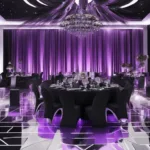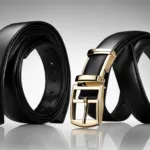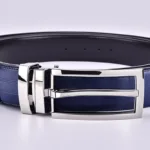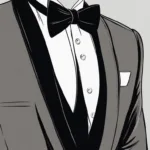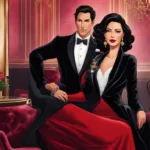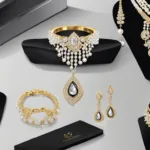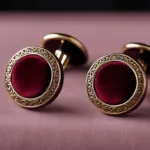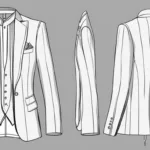Understanding the subtle yet significant black tie vs. white tie differences is paramount for anyone standing at the crossroads of selecting the appropriate attire for formal events. While both represent an elevated standard of dress, discerning the exact requisites and when to don which ensemble can be crucial. The white tie, often considered the zenith of formal event attire, carries with it an aura of traditional grandeur, calling for a meticulously composed outfit that includes the likes of a hand-tied bow tie and a classic evening tailcoat.
Conversely, black tie attire provides a touch of contemporary flexibility within its traditional framework, allowing for dark-colored variations and a broader interpretation that befits a range of prestigious gatherings from award ceremonies to upscale galas. This juxtaposition of dress code distinctions for formal events underscores not only the importance of attention to detail but also an appreciation of ceremonial etiquette.
Key Takeaways
- The white tie is the epitome of formal wear, typically including a white bow tie and evening tailcoat.
- Black tie, while formal, offers slightly more freedom in color and style, perfect for a variety of celebratory events.
- Understanding the dress code distinctions for formal events ensures appropriate attire selection and adherence to social norms.
- Modern adaptations of these dress codes reflect current fashion trends while maintaining traditional elegance.
- Recognizing the occasion’s level of formality is crucial in determining whether black tie or white tie is suitable.
- Both dress codes have a storied past and have evolved to match the aesthetic and ceremonial needs of today’s formal events.
The Historical Significance of White Tie Attire
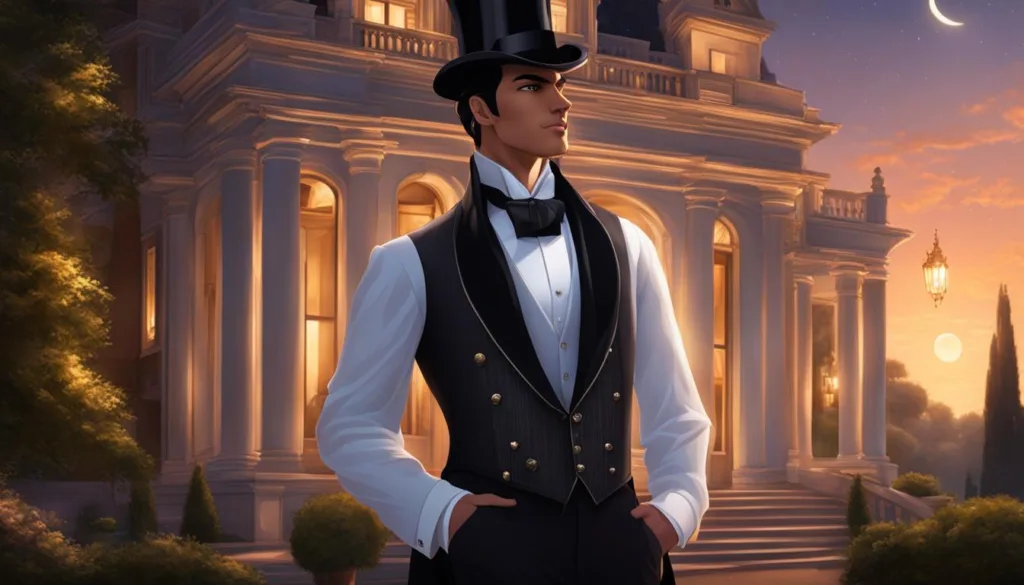
The white tie dress code stands as a sentinel of the grandeur and etiquette that defined the highest tiers of yesteryears’ society. It is a historical artifact that carries the weight of tradition, set within the magnificent tapestries of European aristocracy. With its roots firmly planted in regal tradition, the historical significance of wearing white tie to events extends beyond mere fashion or trend. It is an indelible legacy of sartorial elegance.
Once the preserver of aristocratic decorum, it has come to symbolize the pinnacle of traditional formality within an evolving modern landscape.
Adherence to the white tie dress code was a celebrated norm during royal ceremonies and state balls. Every stitch mirrored the social hierarchy, conveying messages of wealth, power, and an adherence to the refined ways of the aristocratic fashion elite. Medals and decorations adorned the chests of men as an additional display of status, visible emblems of personal achievements and societal standing. This degree of opulence is seldom realized in contemporary fashion, marking white tie events as rare, but treasured, occasions.
- A tribute to the affluent lifestyle of bygone eras
- A demonstration of the most extreme social etiquettes
- An enduring symbol of ceremonial excellence and propriety
Even as society progresses, the allure of the white tie’s past continues to captivate imaginations, retaining its status as the apotheosis of formal attire. Its present-day appearances, although infrequent, are testament to the time-honored traditions that characterized the high society of the past. Strikingly, the white tie dress code remains untouched by time, a true insignia of historical significance.
Understanding White Tie Standards and Etiquette
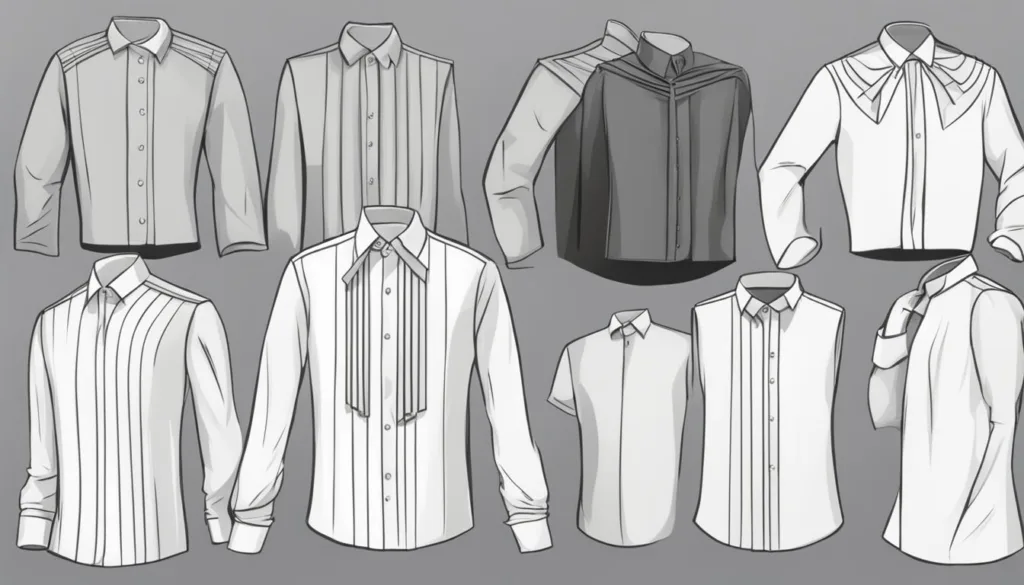
Mastering the white tie dress code is essential for those special occasions where the highest formality is a must. Understanding white tie standards extends beyond mere clothing choice—it’s about embodying an aura of tradition and sophistication. Let’s delve deeper into the elements that set this time-honored style apart, ensuring your formal event attire is up to par when the invitation specifies the pinnacle of formalwear.
The Quintessential Elements of a White Tie Outfit
Every garment in a white tie outfit plays a critical role, from the formal white shirt with its wing collar to the white evening waistcoat, which provides an underpinning of elegance to the ensemble. Adhering strictly to white tie standards, a hand-tied bow tie is mandatory, as are the high-waisted trousers adorned with braid. A finely tailored evening tailcoat completes the look, worn unbuttoned to showcase the waistcoat beneath it. To punctuate this regal attire, mother-of-pearl cufflinks and studs are often selected for their understated yet unmistakable allure.
When to Opt for White Tie Over Other Dress Codes
The question of when to wear white tie is more than a matter of personal choice—it’s dictated by the level of ceremony and tradition the occasion demands. White tie attire is the go-to selection for events steeped in formality and steeped in stature. Whether it’s a state ceremony or a high-society fundraiser, understanding when white tie trumps other dress code distinctions ensures that one’s appearance is not only appropriate but also radiates the respect such events command.
Understanding these dress code distinctions and the quintessential elements of the outfit ensures proper adherence to white tie etiquette, making it clear that when it comes to formal event attire, there are levels of sophistication that can only be achieved through meticulous attention to detail. Thus, recognizing the rich history and strict guidelines upheld in white tie standards is as important as the physical elements of the attire itself.
Decoding Formal Event Attire: Black Tie Essentials
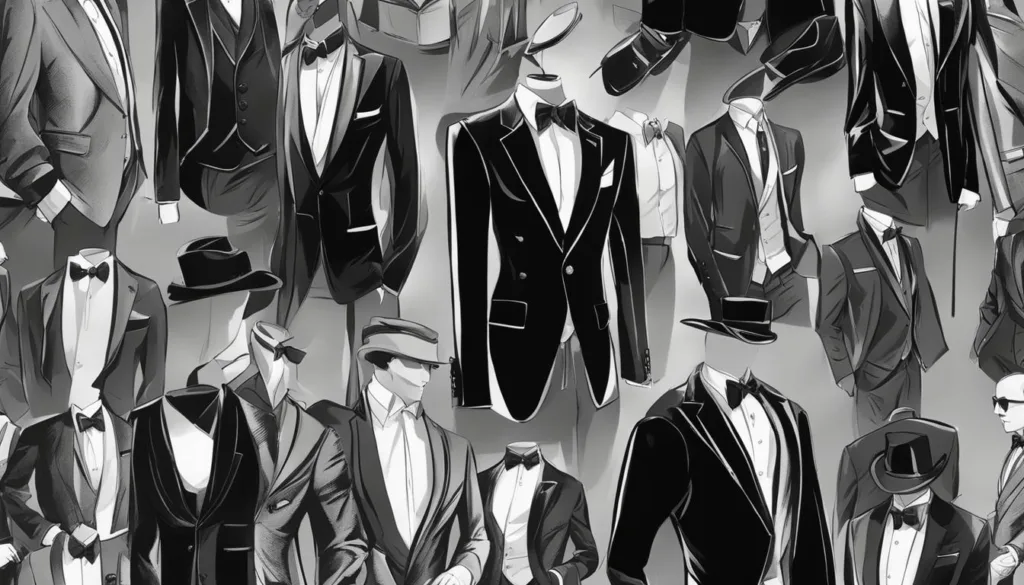
Navigating the nuances of formal event attire, particularly for black tie occasions, requires a clear understanding of the essentials that make up this time-honored dress code. The quintessential formal jacket—tailored to perfection—is the cornerstone of black tie attire. Its complement, a crisp white shirt, elegantly sets the stage for the classic black bow tie, the most recognizable symbol of the black tie ensemble.
Complementary accessories play an equally important role in refining and decoding formal event attire. Cufflinks add a subtle sheen, while a neatly folded pocket square lifts the sophistication of the outfit. Together, these items coalesce to present a poised and polished appearance, befitting any formal occasion that calls for black tie apparel.
| Garment | Description | Importance |
|---|---|---|
| Formal Jacket | Traditionally black, but also acceptable in midnight blue, with silk lapels | The central piece that defines the black tie dress code |
| Formal Shirt | White with pleated front, wing tip or turndown collar | Serves as a backdrop for the bow tie and studs |
| Black Bow Tie | Hand-tied preferred, but pre-tied acceptable | Key identifying feature of black tie attire |
| Accessories | Cufflinks, button studs, pocket square | Add personality and completion to the formal look |
In a sea of sartorial decisions, the objective remains steadfast: to embody a striking vision of elegance. As attendees aim to decipher black tie essentials, they find themselves part of a heritage that celebrates tradition while embracing the individual flair that contemporary fashion allows.
Comparing Black and White Tie: An Overview
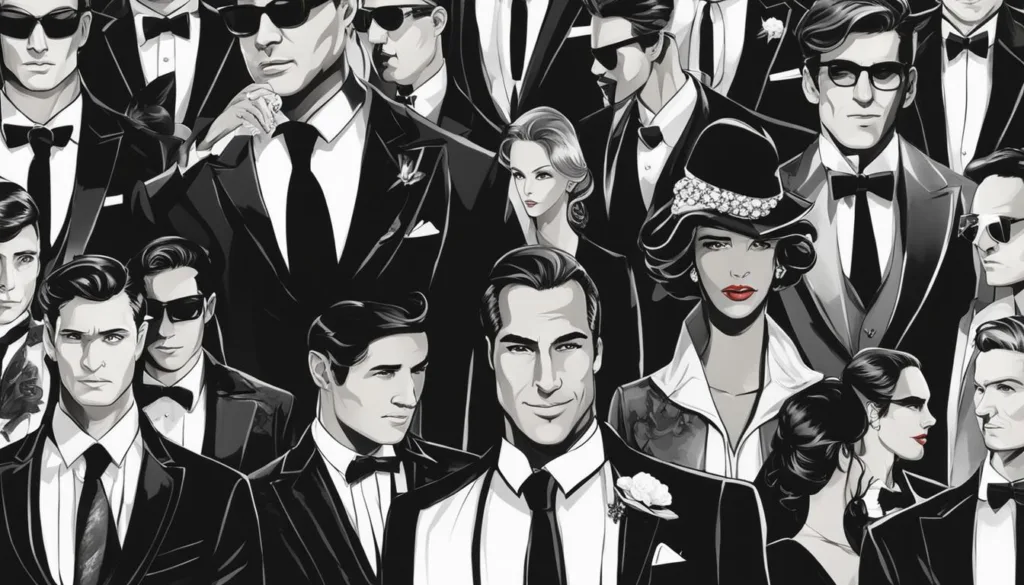
When delving into the world of formal events, comparing black and white tie dress codes reveals distinct traditions and expectations that define the essence of sophistication and elegance. These sartorial choices indicate not only personal style, but also adherence to a set of social etiquettes associated with each level of formality.
Key Differences in Formality Levels
The foremost distinction between the two lies in the formality levels in dress codes, setting the tone for the type of event and the attire it requires. White tie, known for its unparalleled formality, features a rigid structure with its iconic white bow tie, official tailcoat, and an impeccable level of detail from head to toe. Conversely, black tie offers a margin of flexibility, permitting variations in style while still maintaining a highly formal appearance.
Accessories and Accoutrements
Accessories form an integral component of any formal outfit, distinguishing between the black and white tie at a nuanced level. They serve as the finishing touches that can either elevate or scale down the formality of the attire.
| White Tie Accessories | Black Tie Accessories |
|---|---|
| White hand-tied bow ties | Black bow ties |
| Evening tailcoats | Tuxedo jackets |
| White gloves | Leather dress shoes |
| Top hats (optional) | Simple cufflinks |
| Boutonnieres | Conservative pocket squares |
The accessories and accoutrements associated with each dress code are telling of the event’s formality. Where white tie calls for a top hat and white gloves, reflecting historical grandeur, black tie manages to capture a sleek and modern formality through polished yet less ostentatious items like tasteful cufflinks and shoes.
Black Tie vs. White Tie Differences
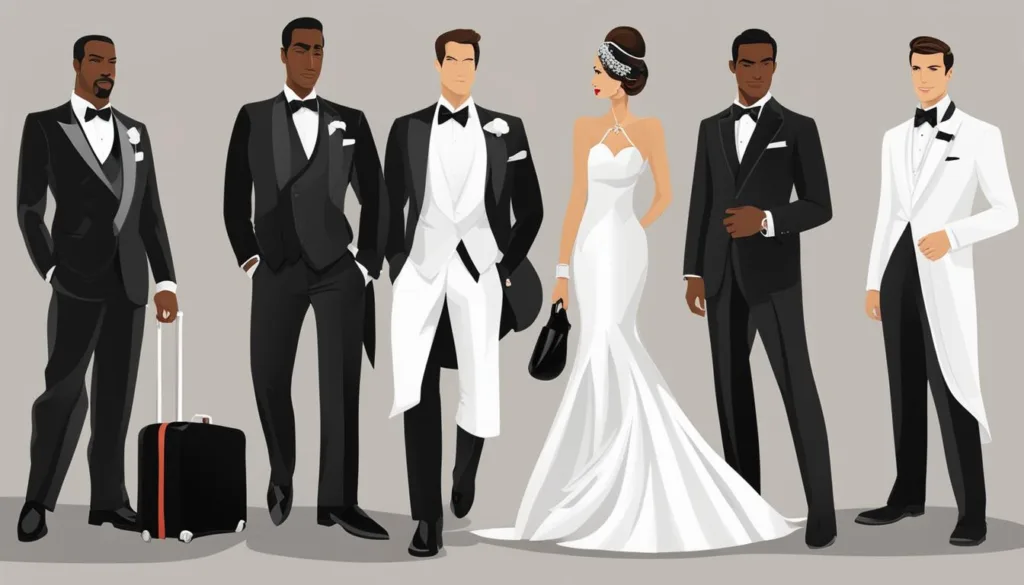
In the intricate world of formal wear, the contrasts between black tie and white tie attire are both subtle and significant. Understanding these differences not only prepares one for selecting the right outfit but also for appreciating the intricacies of each dress code. Below we visually differentiate the two and outline the occasions where each is most appropriate.
Distinguishing Between the Two Dress Codes Visually
The visual differentiation between black tie and white tie is evident in the traditional components of each attire. While black tie and white tie both communicate a high level of sophistication, recognizing the specific elements of each can prevent a faux pas in formal settings.
For gentlemen, the hallmark of white tie is the tailcoat with its characteristic horizontal waist seam. The trousers, unlike those typical of black tie ensembles, are adorned with braids and are worn at a higher waist. The stiffness of a winged collar shirt and the elegance of a hand-tied white bow tie complete the look, signifying the utmost formality.
In contrast, black tie typically calls for a tuxedo—a formal jacket coupled with trousers that carry a single braid down the leg. A black bow tie, matching the lapels of the tuxedo jacket, and patent leather shoes form a polished, yet comparatively less extravagant, appearance than its white tie counterpart.
Occasions When Each Dress Code Is Appropriate
When deciphering appropriate occasions for each dress code, understanding the context is key. White tie events are characterized by grandeur and tradition, while black tie events offer a platform for formal elegance with a touch of modernity.
| White Tie Occasions | Black Tie Occasions |
|---|---|
| State dinners | Weddings |
| Royal affairs | Award ceremonies |
| Diplomatic receptions | Formal galas |
| Debutante balls | Charity fundraisers |
| Opera premieres | Prestigious film premieres |
Irrefutably, each dress code serves its purpose within the mechanics of social etiquette. The opulence of white tie is primarily reserved for the highest tiers of formality, while black tie finds a broader spectrum of acceptance, suitable for an array of dignified, yet slightly less ceremonial, gatherings. Aligning the right attire with the correct occasion is not just a matter of style—it’s about respecting the importance of the event and its time-honored dress expectations.
Distinct Features of White Tie Attire
The world of formal dress codes boasts a range of elegant ensembles, but none as storied and ceremonious as white tie attire. Recognized for its ultimate formality, the white tie sets the standard for high-society events, embodying an unmatched level of sophistication. In this section, we delve into the core elements that make white tie distinctly superior in the hierarchy of formal attire.
Tailcoats and Trousers: The Defining Components
Integral to the white tie dress code are the tailored tailcoats and formal trousers, designed to meet precise specifications. The tailcoat, with its artful construction, forms an unmistakable silhouette, draped elegantly across the shoulders and cutting away to the front. The sharp division at the waist cascades into a pair of tails at the back, a feature virtually synonymous with this dress code.
- Tailcoat: Unbuttoned, with peaked lapels, defining a statuesque profile.
- Trousers: High-waisted with a satin stripe or double braid along the seam, thereby complementing the tailcoat’s dramatic flair.
- White Waistcoat: Low-cut, tailored to perfection, ensuring a cohesive and seamless appearance with the tailcoat.
The meticulous detail that goes into the tailoring of these components reflects the distinct features of white tie attire, with each element playing an integral part in creating the look revered at the most formal of gatherings.
Accessory Selection for Ultimate Formality
No white tie ensemble is complete without the careful selection of accessories that underscore its stateliness. Here, tradition dictates the choices, aligning them with the grandeur of the occasion.
- White Bow Tie: Pure and hand-tied, it sits at the pinnacle of accessory selection.
- Winged Collar Shirt: Stiff and formal, providing a stately frame for the bow tie.
- Mother-of-Pearl Cufflinks and Studs: Adding a touch of subtle embellishment.
- Optional Top Hat and White Gloves: They enhance the traditional feel and ultimate formality, though they are seen less frequently in contemporary use.
The combination of these accessories with the tailored tailcoats and formal trousers cements an individual’s presence within the upper echelons of formal dress codes. Elegance is portrayed not just in the clothing but in the meticulous attention paid to each discernible detail—showcasing a timeless tradition in formalwear that continues to stand as the gold standard in ceremonial dress.
Nuances of Black Tie Attire and Modern Adaptations
The landscape of black tie attire has witnessed significant shifts, accommodating the ever-changing world of fashion. From high-profile events to intimate gatherings, the demand for contemporary fashion adaptations of classic pieces has intensified. Simultaneously, personalization has become a buzzword in the industry, encouraging a blend of traditional style with innovative flair. This evolution underscores the reality that while the roots of black tie are steeped in a formal past, present-day interpretations are increasingly diverse.
Examining the nuances of black tie attire reflects a broader narrative: a canvas where bold statements now parallel understated elegance. Recognizing the importance of adapting to various social circumstances has led to adapting black tie attire in ways that resonate with the individual and the occasion. This malleability is essential, particularly when it comes to non-traditional events that still demand a sharp sartorial sense.
How Black Tie Has Evolved in Contemporary Fashion
Modern advancements in fashion have paved the way for a refined yet relaxed take on black tie dress codes. For example, esteemed brands like Tom Ford have reimagined the black suit with luxurious fabrics, such as silk and velvet, making a statement that is both discreet and dominant. Similarly, designers like Ralph Lauren have introduced subdued patterns and colors into their black tie collections, balancing novelty with the attire’s core principles.
With the advent of these contemporary fashion adaptations, the essence of black tie is not diluted but rather enhanced. It’s a testament to the timeless allure of the style, which allows for such creative flexibility without losing sight of its inherent formality. Today’s men are often seen confidently pairing a classic tuxedo with sneakers or a boldly patterned jacket – a clear sign of evolved fashion sensibilities within black tie parameters.
Adapting Black Tie Attire for Non-Traditional Events
When it comes to non-traditional events or environments that call for black tie attire, there’s been a noticeable shift towards a more eclectic yet appropriate approach. Events such as modern art galas or luxury brand launches invite experimental touches that would have once been considered fashion faux pas. Embroidered details, satin lapels in unexpected hues, and high-end designer footwear have become the accomplices of choice for those aiming to personalize their formal look.
Individuals are no longer confined to the old guard of formality but are rather encouraged to express their individual styles within the ceremonial framework. Whether it’s wearing a statement watch with a tuxedo or embracing unconventional accessories, the latitude provided in current black tie events allows a person’s character to shine through, all while maintaining respect for the event’s formal nature.
As the parameters of formal events continue to evolve, so too does the attire. The nuances and details that define present-day black tie attire convey a narrative of adaptation and individualized elegance, proving that respecting tradition does not preclude innovation.
Black Tie and White Tie Contrasts: Attire for Women
The world of formal events brings with it a refined display of attire for women, distinguishing noticeably between black tie and white tie occasions. While both dress codes exude elegance and sophistication, the expectations for each are distinct, guiding the selection of formal gowns and accessories. Here, we explore these differences further, ensuring clarity and poise for women’s fashion choices at such prestigious gatherings.
| White Tie Attire for Women | Black Tie Attire for Women |
|---|---|
| Floor-length evening gown | Floor-length gown or sophisticated cocktail dress |
| Long gloves | Optional gloves, depending on formality |
| Elegant clutch | Design-savvy clutch or evening bag |
| Refined, perhaps jeweled accessories | High heels and tasteful jewelry |
At white tie events, the attire for women is characterized by grandeur and the highest level of formality. A lady dons a full-length ball gown that touches the ground, creating an echo of the regal past. To complement this, gloves often accompany the ensemble, extending the formality to the fingertips—literally.
Transitioning to a black tie setting, the selection of attire for women broadens, allowing for more personal expression within formal boundaries. Floor-length gowns remain a classic fixture, yet there’s room to elegantly step into a deluxe cocktail dress, making a chic statement appropriate to the event’s tone. High heels, while common to both dress codes, might be chosen with a dash of daring or subtlety to match the gown’s flair.
“Each element of a woman’s formal attire is a brushstroke in the masterpiece that is her presence at a gala. It’s the harmony of gown, accessory, and personal style that composes an unforgettable image.”
Thus, from the luminous chandeliers of a white-tie affair to the sparkling conversations at a black tie soiree, women find themselves wrapped in the fabric of sophistication. As they navigate the contrasts between the formality of a white tie and the versatility of a black tie, the attire they choose becomes a testament to their understanding of such timeless occasions.
Dressing for Couples: Coordinating Black Tie and White Tie Looks
When it comes to formal events, achieving a cohesive style is not just about individual elegance; it’s about creating a unified aesthetic as a couple. Coordinating black tie and white tie looks is about finding balance and harmony between two distinct outfits. It’s a sartorial dance that, when done right, can make both partners shine even brighter together.
Achieving Aesthetic Harmony: Tips for Partners
For couples eager to present a united front in style, here are some key guidelines:
- Select complementary fabrics that reflect the level of the event’s formality, uniting both outfits in texture and sheen.
- Opt for a color palette that allows both outfits to resonate with each other—like a classic black and white combination or subtle color accents that tie into each partner’s attire.
- Accessorizing is crucial; ensure that jewelry, cufflinks, and other accents are in harmony, considering both design and metal choice.
Matching the sophistication and styling detail of each outfit will create an aesthetic dialogue between the looks that is immediately perceptible and highly regarded in any formal setting.
Understanding the Importance of Cohesive Style in Formal Events
In the realm of formal events, the importance of cohesive style cannot be overstated. Dress code coordination is a testament to a couple’s attention to detail and respect for the occasion. An impeccable synchronized look reflects understanding and appreciation of the event’s atmosphere and ceremonies, adding to the significance of their shared experience.
| Aspect | Importance for Black Tie Events | Importance for White Tie Events |
|---|---|---|
| Formality Level | High; elegant tuxedos and gowns | Highest; full evening dresses and tailcoats |
| Color Coordination | Flexible; can incorporate dark hues and accents | Strict; typically adheres to neutral and monochrome schemes |
| Accessory Harmony | Important; cufflinks, ties, and jewelry should complement | Vital; accessories must be traditional and match in terms of formality |
Maintaining an elegant synchrony between partners showcases both personal style and an adherence to tradition, which is especially prominent in settings that observe either black tie or white tie dress codes. It is this unwavering commitment to aesthetic harmony that makes a couple stand out at formal events.
Role of Cultural and Geographical Factors in Formal Dress Codes
The nuanced tapestry of formal attire is profoundly colored by the influence of geography in attire and the cultural factors in dress codes. These elements wield a significant role in what is deemed appropriate or customary for formal wear in various regions around the globe. Let’s explore how local customs and environmental conditions have adapted the stately protocols of black tie and white tie attire to align with regional idiosyncrasies, extending the legacy of these dress codes through a myriad of global examples of formal attire.
How Geography and Local Customs Influence Attire
It’s well-understood that geography has a hand in shaping not just landscapes, but also cultural aesthetics, including how communities interpret formal dress standards. From the arid deserts to the eskers, each locale imparts a unique set of criteria that molds its version of formal attire. The profound influence of geography in attire sees the choice of materials and styles aligning intricately with climatic demands or cultural significance. Black tie and white tie ensembles may thus undergo modifications, be it lighter fabrics for the tropics or heavy, luxe drapery in cooler climes. Regional heritage also infuses prestigious events, as local motifs and traditional attire blend seamlessly with Western formal wear to create ensembles that resonate with cultural pride.
Examples of Black Tie and White Tie Attire Around the World
As you traverse the globe, the narrative of formal attire unfolds distinctly in each region. In Japan, for instance, incorporating elements like the ‘Hakama’ with black tie or ‘Montsuki Haori’ for white tie events subtly honors tradition. Africa’s rich textiles find expression in formal events as well, with vivid ‘Kente’ cloth used for bow ties or cummerbunds. European elegance perhaps remains closest to the classic interpretations of black and white tie, but even here, you’ll notice differences reflecting Mediterranean vivacity or Scandinavian minimalism.
Let’s consider a comparative glance at how black tie and white tie attire have been uniquely shaped by the environments from which they emerge:
| Region | Black Tie Adaptation | White Tie Adaptation |
|---|---|---|
| Middle East | Lightweight materials, with a potential mix of traditional ‘Bisht’ cloak | White ‘Thobe’ with tailcoat elements |
| Caribbean | Brighter color palette; linens substituting wool | Less emphasis on tailcoats, leaning towards cultural formal wear |
| South Asia | ‘Sherwani’ combined with formal trousers | ‘Achkans’ paired with traditional royal turbans |
| South America | Flamboyant accessories complementing classic suits | Formal military uniforms for state events |
These adaptations signify the resilience and flexibility of black tie and white tie dress codes, affirmatively nodding to the evolving narrative of formal attire influenced by the richness of our world’s tapestry. They embody the delicate balance between upholding globally recognized standards of formal wear, while interweaving the local customs and geographical influences that bring vibrancy to the global stage of ceremonial dress.
Choosing the Right Attire: Expert Tips for Formal Events
Navigating the myriad of dress code requirements for formal events can be a daunting task. However, by adhering to expert tips for formal events and understanding the nuances between black tie vs. white tie, selecting suitable attire becomes a manageable endeavor. Below, insights are provided to assist in making an informed decision that respects formal dress etiquette and aligns with dress code specifications.
Guidelines for Selecting the Suitable Outfit: Black Tie or White Tie
When deciding whether to dress in black tie or white tie, consider the nature of the event. A tuxedo with satin lapels, a formal white shirt, black patent shoes, and a black bow tie exemplifies black tie’s classic charm. For white tie events, which represent the highest level of formality, nothing less than a tailcoat, a white piqué waistcoat, white bow tie, and possibly even white kid gloves will suffice.
Navigating Dress Code Specifications and Expectations
Respecting an event’s formality entails a clear grasp of the expected attire. Understanding the difference between the two can be simplified with a simple visual breakdown:
| Specification | Black Tie | White Tie |
|---|---|---|
| Occasions | Galas, Premieres, Weddings | State Dinners, Debutante Balls, Diplomatic Ceremonies |
| Main Attire | Tuxedo | Evening Tailcoat |
| Shirt | White Formal Shirt | White Wing-Collar Shirt |
| Tie | Black Bow Tie | White Bow Tie |
| Shoes | Black Patent Leather | Black Patent Leather or Court Shoes |
| Accessories | Cufflinks, Pocket Square | White Gloves, Top Hat (optional) |
With this guidance, individuals can confidently navigate formal expectations, ensuring they maintain appropriate formal dress etiquette no matter the requirement. Expert guidance suggests prioritizing venue, event time, and explicit dress code details to make an appropriate selection.
Conclusion
In the realm of formal events, the distinction between black tie and white tie is far more than a matter of color. Understanding the differences in dress codes is essential for anyone looking to partake in events with elegance and respect for tradition. The nuances of black tie vs. white tie differences provide a lesson in historical fashion evolution, decoding formal event attire with an eye for detail, and embodying the transformative power that comes with dressing the part.
As our journey through the meticulous world of formal dress codes concludes, we underscore the importance of appreciating the subtle yet significant nuances that distinguish these two standards of attire. Both black tie and white tie have their unique set of rules, accessories, and occasions, making the understanding of dress code distinctions indispensable. As cultural and social landscapes evolve, these dress codes stand as beacons of social sophistication and decorum.
With this knowledge, individuals can step into any formal gathering with a sure step, exuding confidence and poise. Whether opting for the grandeur of white tie or the classic finesse of black tie, one can navigate these sartorial waters with the assurance that they are upholding the very tenets of formal tradition. Ultimately, the mastery of these dress codes empowers individuals to celebrate the timeless elegance that these events represent, with respect for their enduring legacies.




